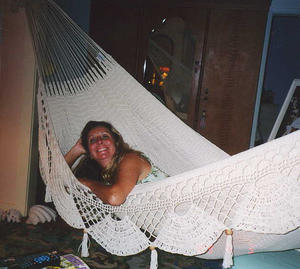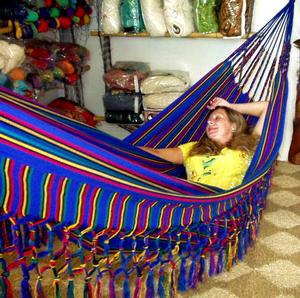| |
 Overwhelmingly,
the Hammocks that dazzle the senses, relax the body, and still the mind are the products of native artisans
in Mexico and Central and South America, working by hand the ancient craft of the Maya. These fabulous hammocks
surpass all others in comfort as well as in beauty. The Yucatan of Mexico, Colombia, Nicaragua, and Brazil
all produce fine hammocks in differing styles, but with a commitment to comfort, durability and
beauty. Mexican and Nicaraguan hammocks are woven by hand, using a sprang woven open mesh weaving technique.l The
Mexican style uses thin strings for maximum ventilation, and no ornament other than the beautiful colors
used in the design. The Nicaraguan Hammock uses a thicker string, which adds to its sturdiness and durability,
is double sprang woven, and also can include beautiful decorative fringes, which can double as light blankets. Overwhelmingly,
the Hammocks that dazzle the senses, relax the body, and still the mind are the products of native artisans
in Mexico and Central and South America, working by hand the ancient craft of the Maya. These fabulous hammocks
surpass all others in comfort as well as in beauty. The Yucatan of Mexico, Colombia, Nicaragua, and Brazil
all produce fine hammocks in differing styles, but with a commitment to comfort, durability and
beauty. Mexican and Nicaraguan hammocks are woven by hand, using a sprang woven open mesh weaving technique.l The
Mexican style uses thin strings for maximum ventilation, and no ornament other than the beautiful colors
used in the design. The Nicaraguan Hammock uses a thicker string, which adds to its sturdiness and durability,
is double sprang woven, and also can include beautiful decorative fringes, which can double as light blankets.
The originators of this style of incredibly comfortable hammock were the ancient Maya. This
brilliant people, who devised a highly advanced mathematics, strongly built pyramids, and a fascinating calendar
that accurately predicted the future, developed the hammock as a comfortable and safe alternative to sleeping
on the ground, subject to attack from insects and predators. For over 1000 years, Maya Indians have used hammocks
as beds. They were conceived in hammocks, born in them, slept in them, and died peacefully in them, that is,
if they did not have the misfortune of being mutilated, shredded and killed as human sacrifice in the ancient
Mayan religious festivals. The hammock was designed to be safe as well as comfortable, fashioned in a "sprang
woven" style, which allows the hammock to be able to expand from the size and and shape of a large ship's
hawser to six to eight feet across or even wider. This stretching weave provides a constant support as you
move about within the hammock. It is literally possible to become more comfortable in a hammock than in any
other device known to man with the possible exception of a float tank.
The weaving style of the Ancient Maya followed their course of empire throughout Central and
Northern South America. The descendants of the Maya weave hammocks today in small villages in the Yucatan.
and Central America. Their techniques of weaving originated in the dim past of these ancient people, whose
civilization began two Millennia BC and evolved with them over the centuries. By the time of the Spanish conquest
hammock weaving had evolved to its current state of development, using fibers from the Hamac tree. Today,
cotton fibers give the beds of the hammock a wonderful luxurious comfort, while nylon cord provide powerful
suspension. The Hamaca Maya of the Yucatan is considered to be the finest of their type in the world. Each
hammock has up to two miles of quality cord and can take an experienced weaver 40 to 90 hours to complete.
Soft to the touch, they are amazingly strong, capable of holding hundreds of pounds. Some have even been pictured
holding the weight of a napping Volkswagon! Even though they stretch out as long as fourteen or fifteen feet
they fold up into a light compact bundle smaller than a pillow. |
Eulogist, poet and hammock historian, James J. Bogan says: "It is not often scholars
can cite the first day a word entered a language but in 1500 on the 27th of April, a Monday, the Portuguese
explorer Pero Vaz de Caminha walked along a sandy beach in Brazil. On that day he noted in his journal: "In
their thatched houses the natives sleep in NETS that are attached with cords to the wooden beams above. Below
always burns a small fire to keep them warm and to repel bugs and demons." He saw an Indian dozing happily
in what looked like a fishing net, and so from that day the Portuguese expression for hammock is rede de dormir: "a
net for sleeping."
In English, the word "hammock" came by way of Spanish conquistadors,who derived the word hommoca from the Caribs,
who wove fibers of the hammok tree. The ferocious Caribs learned the craft from a people they had conquered,
the inventive, but more peaceable, Arawak tribe whose own word hammock--ini--translates as: "bed-threads."
And what is more peaceable than a hammock? It accompanies us from our first day to our last: it is our
cradle, our nuptial bower, our sickbed, our coffin."
 In
the Mayan catalog, the hammocks are woven with an all cotton bed for supreme comfort, and nylon end strings
for long lasting support. The cotton fiber produces a feel like that of a soft bed. For those contemplating
indoor use, cotton is the fabric of choice. Cotton is also an excellent fabric for a hammock for outdoor
use, if it is cared for properly. Left outside to weather it will begin to fade after a year or so and to
rot after two years. In
the Mayan catalog, the hammocks are woven with an all cotton bed for supreme comfort, and nylon end strings
for long lasting support. The cotton fiber produces a feel like that of a soft bed. For those contemplating
indoor use, cotton is the fabric of choice. Cotton is also an excellent fabric for a hammock for outdoor
use, if it is cared for properly. Left outside to weather it will begin to fade after a year or so and to
rot after two years.
Because of their weaving style Mayan Hammocks support the back more thoroughly than most beds
can do. Beds, by the nature of their construction cause pressure to build up at certain points in the body,
resulting in tossing, turning, and backaches for many.
Nylon, which produces the feel of a firm mattress, takes brighter colors, and is stronger,
lasts better for outdoor use. Whichever fiber you choose, please see our care
and handling section to learn how to get the longest possible period of enjoyment. For more on
the use of hammocks as beds and as therapeutic tools for back problems and stress see the bed and back section
of the Tommy Hamaca Story
|
 Nicamaka
Hammocks & Hamaca Products: Nicamaka hammocks & hamaca products start with factory-dyed,
high quality imported polyester, polycotton or cotton yarns, that artisans twist into cords, sprang-weave
the beds, crochet the side borders and perform all of the detail and finish work by hand. The result is
consistent high-level quality, pride of craftsmanship by the artisans and enjoyment for the user. Nicamaka�'s
are truly a signature Nicaraguan hammock. Nicamaka
Hammocks & Hamaca Products: Nicamaka hammocks & hamaca products start with factory-dyed,
high quality imported polyester, polycotton or cotton yarns, that artisans twist into cords, sprang-weave
the beds, crochet the side borders and perform all of the detail and finish work by hand. The result is
consistent high-level quality, pride of craftsmanship by the artisans and enjoyment for the user. Nicamaka�'s
are truly a signature Nicaraguan hammock.
Main Entry: Sprang Weaving
Function: noun
Etymology: probably from Norwegian, a kind of embroidery
Date: 1951
: a weaving technique in which threads or cords are intertwined and twisted over one another
to form an openwork mesh
|
Hammocks From Brazil and Colombia
 The
Brazilian hammock is cross woven by hand in cotton, with the warp yarns pulled through to produce the support
strings. These brilliantly colored and wonderfully comfortable relaxation and sleep vehicles are produced
with a canvas like soft supple bed and lovely adornments. These hammocks are extremely comfortable and supportive.
They differ from the Mayan and Nicaraguan hammocks in that they are not ventilated within the weave, and
are, therefore, less cooling in the summer heat. By the same token, however, they are splendid for cooler
climates and mild weather use. Many people prefer these hammocks for sleeping and overnight use because they
are tighter woven, and feel very secure. Our Brazilian Hammocks are produced in vibrant colors, of 100% cotton
fabric. They are ornately fringed and suitable for hanging in high attach hammock stands or the same other
methods that are suitable for the Mayan and Nicaraguan styles. The
Brazilian hammock is cross woven by hand in cotton, with the warp yarns pulled through to produce the support
strings. These brilliantly colored and wonderfully comfortable relaxation and sleep vehicles are produced
with a canvas like soft supple bed and lovely adornments. These hammocks are extremely comfortable and supportive.
They differ from the Mayan and Nicaraguan hammocks in that they are not ventilated within the weave, and
are, therefore, less cooling in the summer heat. By the same token, however, they are splendid for cooler
climates and mild weather use. Many people prefer these hammocks for sleeping and overnight use because they
are tighter woven, and feel very secure. Our Brazilian Hammocks are produced in vibrant colors, of 100% cotton
fabric. They are ornately fringed and suitable for hanging in high attach hammock stands or the same other
methods that are suitable for the Mayan and Nicaraguan styles.
The hammocks of Colombia and Ecuador are ideal for indoor and outdoor use. Like the Brazilian they are
cross woven. At Seaside we stock these hammocks produced with cotton in beautifully dyed fabric. These hammocks are an incredible value for
beauty, comfort, and durability. |
|
|